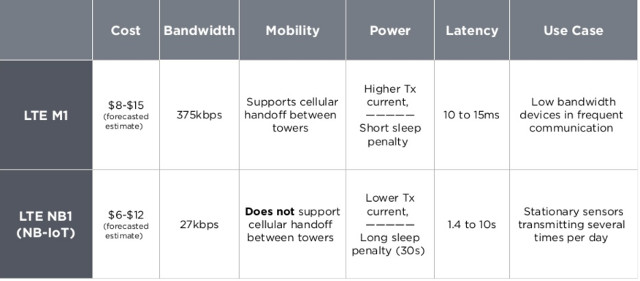Telecom companies also want their share of the IoT business, but with 2G to 4G cellular technology often being too power hungry and/or expensive for this market, 2G on-going – or upcoming – sunset depending on your location, LTE Cat M1 and LTE Cat NB1 (aka NB-IoT) standards have been developed, and used in products like Pycom FiPy board, and SARA-R4 and SARA-M2 modules. If you want to have an overview learn about the new LTE IoT standards and the future of cellular IoT, Particle has published a useful presentation – embedded below – dealing with both, as well as eSIM (Embedded SIM), 2G sunset, and battery life expectations.
 The main takeaways from my reading of the presentation:
The main takeaways from my reading of the presentation:
- LTE NB1 is better suited for low power stationary sensors transmitting a small amount of data a few times a day. Requires new hardware and software
- LTE M1 can be used for actuators and sensors that needs frequent updates. Requires software update to existing base stations.
- eSIM are becoming more and more common, and a “blank eSIM” can be activated anywhere in the world by a local mobile network operator. The many LTE bands across operators and countries however complicates things.
- Consider LTE modules with 3G fallback in markets where LTE is just starting
- The proclaimed 10 to 15 year battery life is mostly hype with a very large battery and one daily update, with real use cases likely to last 12 to 18 months on a battery charge.
If you are interested in the subject, you may want to read through Particle’s 39-page presentation.

Jean-Luc started CNX Software in 2010 as a part-time endeavor, before quitting his job as a software engineering manager, and starting to write daily news, and reviews full time later in 2011.
Support CNX Software! Donate via cryptocurrencies, become a Patron on Patreon, or purchase goods on Amazon or Aliexpress




